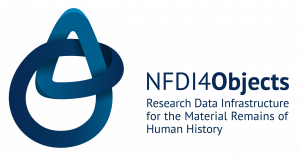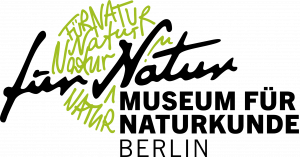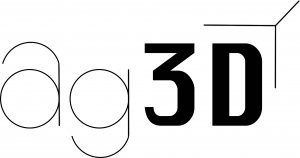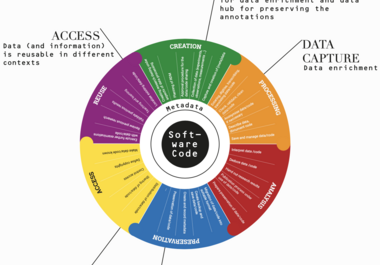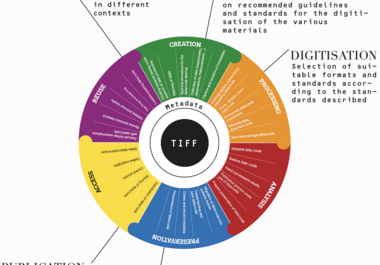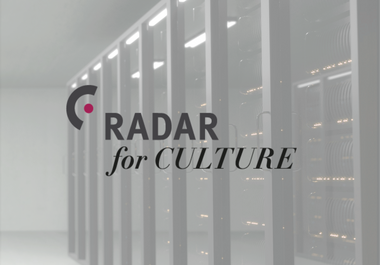NFDI4Culture Use Case
Creative Collaboration Opens New Dimensions in Research: The Cross-NFDI Hackathon 2022
By Dr. des. Katja Sternitzke and Zoe Schubert, M. A.
Keywords
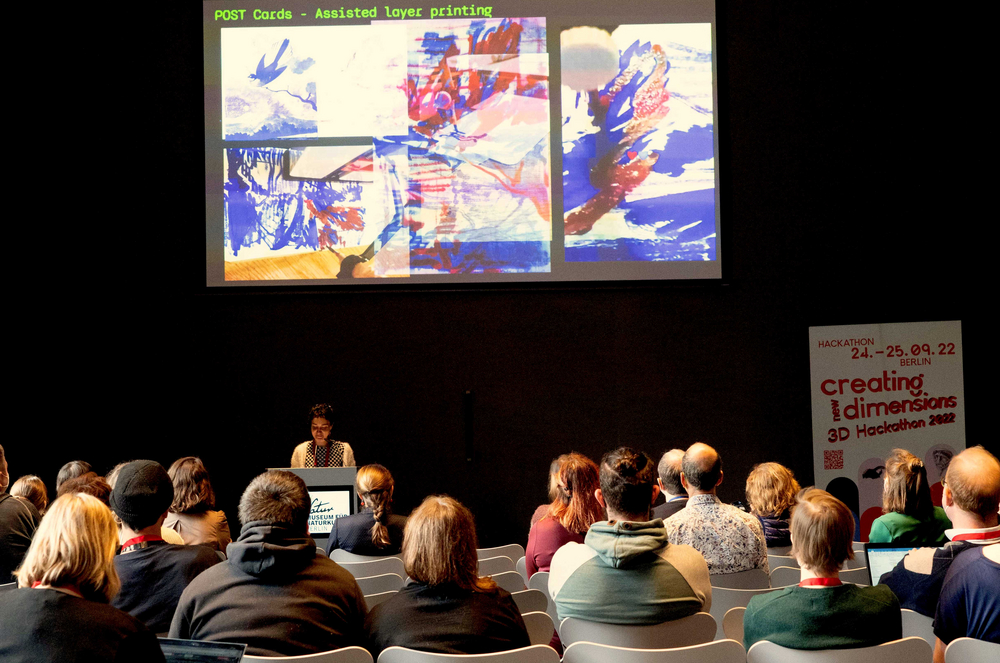
Sol Sarratea presents her project "These cover the Sea" at the final.
"Sol Sarratea presents her project "These cover the Sea" (together with John Woitkowitz, not on stage). They programmed a website on which one can split nature images from George Forster's excursions to the South Seas into chromatic layers and reassemble the images. The picture shows a "printer" built by Sarratea himself, who paints the digitally created pictures with brush and paint. The project won in the category "Größte Gestaltungsfreiheit"." CC BY Creator: Eran Wolff
At many museums, university collections, and research libraries, treasures lie dormant in the form of research data that have not been publicly accessible until now. These research data have been created with great effort and care. They have been prepared and maintained with the hope that they will generate added scientific value.
However, these data are important not only for our own research but also in the context of future research projects and for the interested public. The question arises: how can they be made openly reusable and visible?
The first Cross-NFDI Hackathon in the fall of 2022, organized by the Staatsbibliothek Berlin, aimed to unearth these hidden treasures.
All interested data providers were explicitly welcomed, regardless of whether their research data was already openly available at the time of entry or not. Thanks to the excellent networking of the NFDI consortia, it quickly became clear that the invitation could and should be extended across disciplines. While NFDI4Culture included its humanities communities, the spectrum was broadened by cooperation with NFDI4Objects for the material remains of human history and the life sciences-oriented NFDI4Biodiversity.
The focus was on 3D media, which was of particular interest to various partner institutions. The submitted data could either already contain 3D models, or these could also emerge as a creative end product.
The 3D hackathon put our historic natural history objects in a new light and greatly expanded the multi-perspectivity on our research-driven collection. Great event!

Nadja Hannemann | Museum für Naturkunde Berlin – Leibniz-Institut für Evolutions- und Biodiversitätsforschung
The NFDI4Culture and NFDI4Biodiversity 3D Hackathon gave us insights into the community and raised awareness of our data and the interdisciplinary academy project CVMA.

Anja Gerber | Klassik Stiftung Weimar
The NFDI4Culture Hackathon impressively showed me how much potential there can be in the use of digitized cultural assets

Louise Tharandt, M.A. | MusterFabrik Berlin
The hackathon and the journey to DH 2023 as the "Best Hack" team inspired me to continue my development in Digital Humanities after graduation.
The hackathon allowed me to network with many colleagues who face similar digital challenges as my institution.

Ann-Christin Wachtel | Thüringer Universitäts- und Landesbibliothek Jena
A classic hackathon is an event where people with different skills meet to develop software applications together within one day or weekend. The term "hack" indicates that the aim is to find practical solutions to challenges in a creative, experimental, or in unusual ways.
Few of the data providers had any previous experience with the concept of a hackathon. The starting point was therefore a diverse collection of very differently enriched research data, including data that had not been openly available before. A series of workshops and individual sessions were used to introduce the concept of hackathons and the topic of open data, and to highlight individual data sets together with the NFDI4Culture team.
Where desired, the help of the 4Culture Helpdesk was available, for example, for questions about metadata, standards, or ethical-legal issues. In cases where the data provider had no publication platforms of their own, the freshly launched RADAR4Culture data repository service was made available. This was a win-win situation for all, as the service could be improved and further developed with the 3D Hackathon data at the same time.
Twenty-seven cultural institutions, museums, and university collections from all over Germany and Switzerland joined the call and, after some impressive sprints, proudly made their thirty-four datasets available under open licenses.
At the kick-off event in September 2022 at the Staatsbibliothek Berlin, they finally met hackers, 3D designers, and coders from different parts of Europe. An enthusiastic exchange generated a wealth of ideas and the first teams formed.
During the following four weeks, the hacker teams were in constant exchange with "their" data providers and worked intensively on developing innovative applications and projects. At the finale at the Museum für Naturkunde in Berlin in October 2022, everyone met again: ten teams presented to the data providers and the public what they had creatively developed with the submitted data sets: a whole kaleidoscope of projects, from virtual mountain farming experiences, to 3D postcard editors, and interactive apps. The best, most innovative, most technically sophisticated hacks were awarded prizes by a jury, but the public could also vote for their favorite project.
What made this cross-NFDI hackathon special was that it celebrated collaboration not only across institutional boundaries and communities but also across scientific disciplines. Projects creatively mixed 3D-scanned Hercules beetles, masks, coins, snakeheads, busts, globes, portrait photographs, and more to create new applications and designs. The participating institutions thus came up with completely unexpected combinations of their data and gained exciting new perspectives. In addition, they reached out not only to other disciplines, but also to the interested public, and received working prototypes for reuse in their institutions.
The data donors were highly motivated in the sometimes intensive revision of the data and were rewarded for this because three things came to fruition: 1. the data can now be reused more easily. 2. the data become more visible and better known. 3. they were amazed at what else was in their data.
This unique event in Berlin was put together with the support of NFDI4Biodiversity, NFDI4Objects, and AG3D and was only the first of hopefully many to follow.
All details, all datasets, and all projects can be found on the website: https://creating-new-dimensions.org/ for review.


